
St Anne's Anglican Church, Gresford
[Photograph by Trevor Bunning (May 2010)]

St Anne's Anglican Church, Gresford
[Photograph by Trevor Bunning (May 2010)]
Historical and Technical Documentation by Geoffrey Cox
© OHTA 2014 (last updated April 2014)
Gresford is situated around 190 km north of Sydney, between the Paterson and Allyn Rivers. The area was first accessed by timber getters in the early 1820s, and a wine industry flourished in the second half of the nineteenth century.
The present St Anne's Church was consecrated in November 1898, but the history of the parish extends back to the 1840s. The following account of the 1898 consecration, from The Maitland Daily Mercury, relates some of this history:
St. Anne's Church, Gresford
THE CONSECRATIONYesterday (Prince of Wales' Birthday) will long be remembered as a red letter day in the annals of the Gresford district, it being the occasion when the interesting ceremony of the consecution of the new church of St. Anne's was performed by his Lordship the Bishop of Newcastle.
The new building is a neat brick structure in the early Gothic style, … The east window is a stained triple one, and is in memory of Senior Francis Maronco. It is exceedingly handsome. The other windows, twelve in all, are of ground cathedral glass.
The church is built on the site upon which the wooden church, lately removed, has stood for 49 years, and stands in the centre of the picturesque little cemetery, in which rest the remains of many of the pioneers of the district. The architect is Mr. J. C. Luscombe, of Muswellbrook. His brother the Rev. P. S. Luscombe was the incumbent of the parish at the time the movement for the erection of the new church was started. …
An interesting fact in connection with the new building is that in the year 1845, the first Bishop of Australia, the Right Rev. William Grant Broughton, D.D., visited Gresford to lay the foundation stone of St. Anne's church. But upon his arrival some difficulty arose as to securing the site, and the ceremony was not proceeded with, the stone as prepared being left upon the ground.Some short time afterwards the old wooden church was erected upon the site, and over the foundation stone, which has laid all that time under its floor. The old wooden building has done duty for about half a century, and when demolished to make room for the new structure, the old stone was discovered under the floor. The stone was worn, but it has been furnished with a marble face and has been used as the foundation stone for the new building. The name of Bishop Broughton with the year 1845, being inscribed upon it in association with that of Dr. Stanton, and the record of its laying in the present year 1898.1

Wrought-iron gate to the churchyard, St Anne's, Gresford
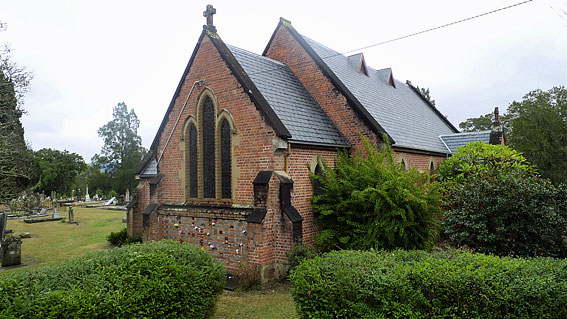
East end of St Anne's Anglican Church, Gresford

Interior of St Anne's Anglican Church, Gresford
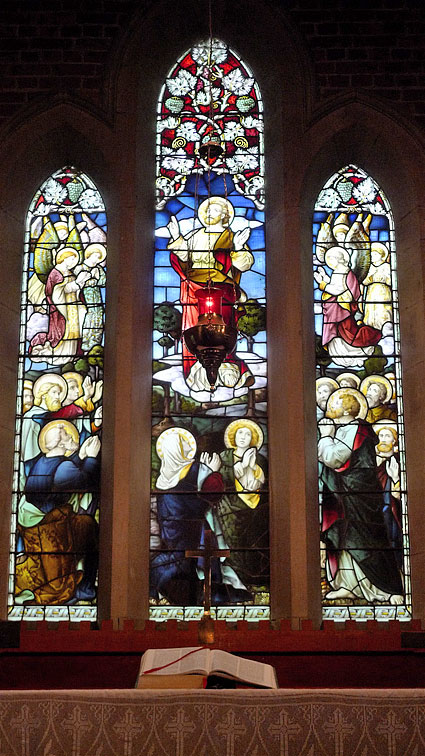
East window in memory of Senior Francis Maronco.
[Photographs by Trevor Bunning (May 2010)]
The organ was built by Whitehouse Bros of Brisbane in 1954. The entry in the firm's Ledger is barely legible,2 but the Whitehouse summary list gives '5th Jan. 1954 New £1,870.7.8'.3
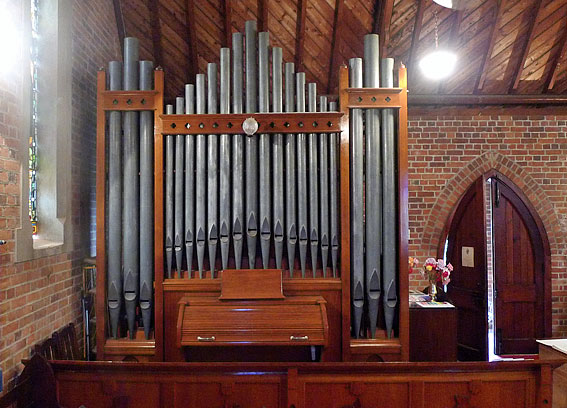

The 1954 Whitehouse organ
[Photographs by Trevor Bunning (May 2010)
Three of the five stops are enclosed, and the specification is as follows:
Manual |
8 8 8 4 16 |
* |
* Unenclosed to Tenor C
Tremulant
Tubular-pneumatic action
Attached stop-key console
Compass: 61/30
Balanced swell pedal.4
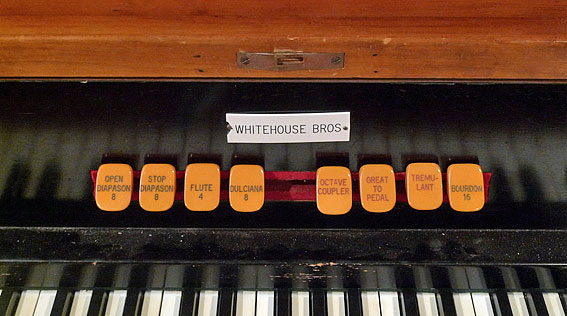
Console details of the 1954 Whitehouse organ
[Photograph by Trevor Bunning (May 2010)
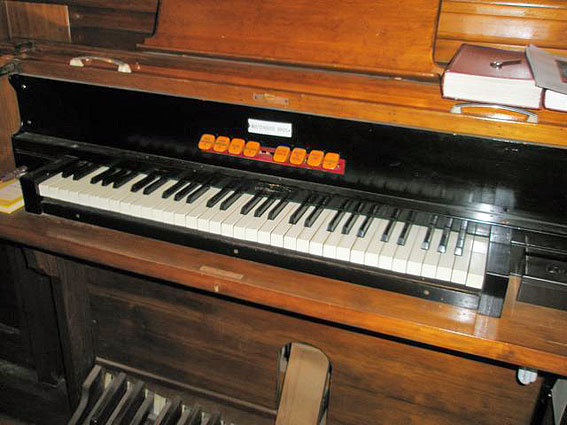
Console details of the 1954 Whitehouse organ
[Photograph by David Evans (October 2009)
The organ was restored in 2003 by Ian Brown & Associates of Ballina, who described the work as follows:
We undertook a complete restoration of the instrument, mostly during the February heat wave … a new silent blower was provided. The bellows were releathered. All of the pipes were removed and cleaned. The metal canister stoppers were refelted. All perishable parts of the pneumatic action were replaced. Once again we were impressed with the performance of pneumatic puffers made of "Polypel" compared to the thin leather ones. Not only will this material outlast leather by about three times, it is so airtight that the action becomes far more responsive. This little organ is now in good order and it is pleasing to know that it will be there working well for many years into the future.5
Whitehouse Bros had built an instrument similar to the Gresford one for Holy Trinity Anglican Church, Goondiwindi in 1952. Both are of five stops, including an Open Diapason 8ft, but the specifications are otherwise different. Although the Whitehouse firm had been building organs with electro-pneumatic action from the 1930s onwards, they continued to use pneumatic action as late as 1957, when they built a similarly small instrument at St Finbar's Catholic Church, Ashgrove. These instruments of the 1950s were possibly the last in Australia (or anywhere) built with tubular-pneumatic action.
____________________
1 The Maitland Daily Mercury (Thursday, 10 November 1898), p. 2.
2 Whitehouse Bros Ledger (1940-1954), p. 691.
3 Whitehouse Bros List.
4 Specification supplied by David Evans (September 1977), and from photographs by Trevor Bunning (May 2010).
5 Ian D. Brown & Associates, 'Off the Chest: St Anne's Church, Gresford,' The Sydney Organ Journal, vol. 34, no. 4 (Spring 2003), p. 40.